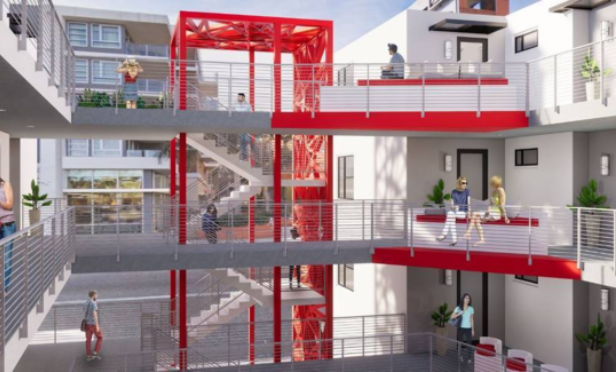 Co-living housing models are rapidly growing in popularity. KTGY is now expanding Co-Dwell, its co-living program, in response to the increasing popularity and demand for more affordable living spaces. Co-Dwell complexes are a collection of micro-units with shared amenities and common spaces. Individual units have small kitchens and living areas with as many as four bedrooms. The concept is meant to provide both better affordability and quality of life.
Co-living housing models are rapidly growing in popularity. KTGY is now expanding Co-Dwell, its co-living program, in response to the increasing popularity and demand for more affordable living spaces. Co-Dwell complexes are a collection of micro-units with shared amenities and common spaces. Individual units have small kitchens and living areas with as many as four bedrooms. The concept is meant to provide both better affordability and quality of life.
“The housing affordability crisis in America is a major issue on our minds as residential architects,” Aimee Ho, a senior designer at KTGY. “The amount of affordable housing needed cannot be built fast enough, so the R+D Studio wanted to explore how building design and the way people live could create an attainable housing model to address this national crisis.”
The co-living model actually has a broad range of benefits in addition to affordability, like shared living responsibilities and community programs, and it provides benefits, like child care and elder care “Resident programming, community formation, and resource sharing are some of the benefits of the co-living model. In addition to direct savings on rent, the Co-Dwell concept offers indirect savings such as the sharing of utilities, household supplies, groceries, and transportation, generating significant economic benefits within co-living communities,” says Ho. “Programming of social events and meal sharing help to build a sense of community and make resource and skill sharing financially valuable for all residents while also creating a much-needed support network.”
The model is also ideal for single millennials, but can also accommodate young, small families in the two-bedroom unit plans. “Beyond the economic benefits, the building design encourages social interaction and enhanced security by orienting the residential units internally, towards the common courtyard,” says Ho. “Walkways are vertically connected with an open stairway, creating transparency within the horizontal and vertical circulation and providing residents a visual connection to their neighbors.”
The idea of shared living is to amp up the benefits of shared living spaces while minimizing the challenges, and this is largely done through the design of the spaces. Additionally, by increasing density in a single building, it is also a model that works well for growing cities and urban centers with limited housing. “Co-Dwell, by design, aims to optimize the use of common amenities and resources while keeping a strong sense of community,” says Ho. “We considered the unit design, number of units, and potential number of residents when designing the building plan and size of common areas. Co-Dwell has comparable density to other four-story on-grade affordable apartments, but this concept could be used in higher density building types, with design modifications to the building plan and common area programs.”
© Touchpoint Markets, All Rights Reserved. Request academic re-use from www.copyright.com. All other uses, submit a request to [email protected]. For more inforrmation visit Asset & Logo Licensing.






